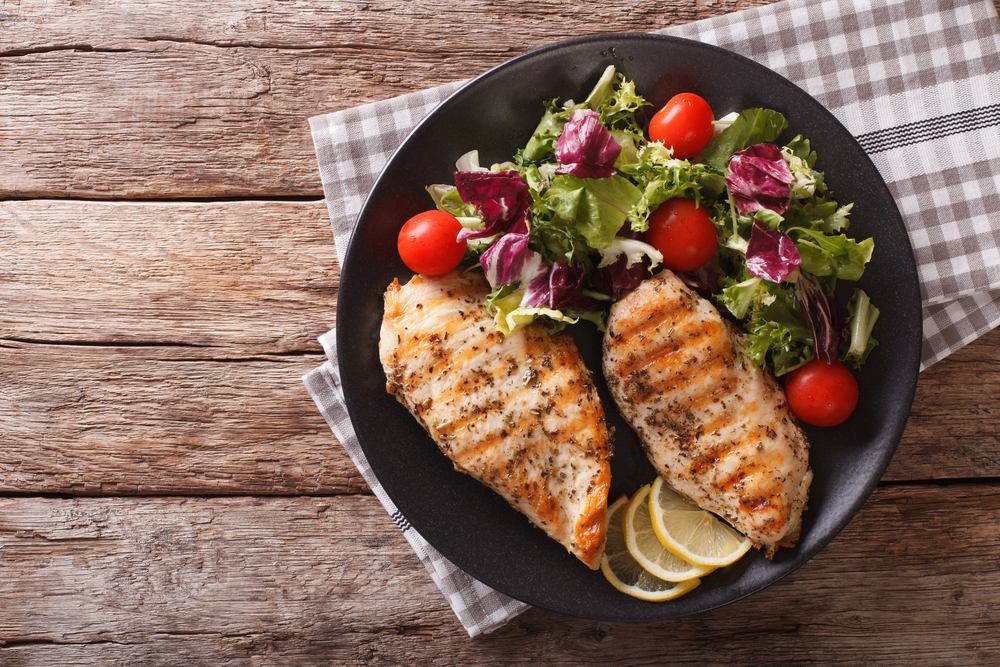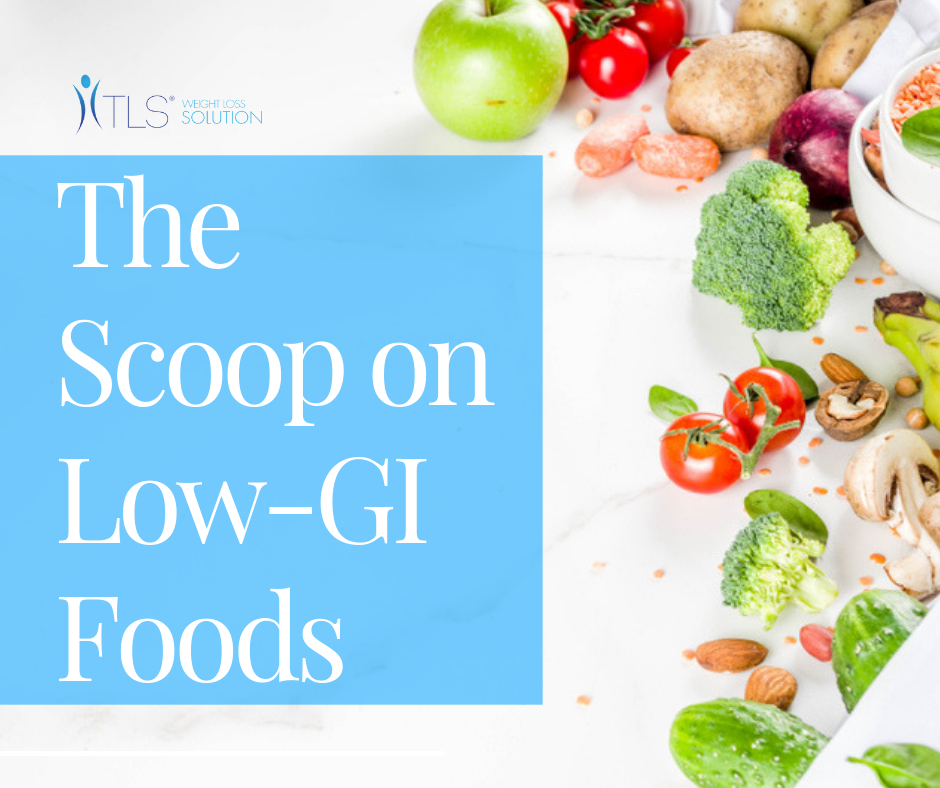By: Amanda Belo
As your body’s favorite fuel, carbs play a major role in everyday blood sugar fluctuations. But you aren’t supposed to go anywhere near carbs when you’re losing weight, right? Actually, you can with a low glycemic-impact (Low GI) diet! Find out why this has been the foundation of Transitions Lifestyle System® since the very beginning.
What is the glycemic index (GI)?
The GI is a ranking system of how food affects glucose (blood sugar) levels – specifically foods that contain carbohydrates. The index ranges from zero to 100 and categorizes foods into three different groups:
- Low GI (1 – 55)
- Medium GI (56 – 69)
- High GI (70 +).1
The lower GI a food is, the less it causes the blood sugar to rise after you eat it. This is because the body digests, absorbs, and metabolizes foods with a higher GI ranking into the bloodstream quicker than foods with a low GI.2

Benefits of Glycemic Index for Meal Planning
The glycemic index was initially designed for diabetics as a tool to avoid foods that might raise blood sugar,1 but studies have shown that eating more low GI foods may also help and support:
- Healthy weight management 1,3
- Healthy blood sugar levels 1,3
- Healthy cholesterol and triglyceride levels1,3
- Satiety and appetite control1
Using the glycemic index to guide food choices provides a few valuable benefits, especially when you’re meal planning for weight loss! Knowing that different sources of carbs affect blood sugar differently allows you to choose a combination of foods more likely to keep your blood sugar levels consistent, and this may help with supporting energy levels throughout the day! In addition, a low Glycemic Impact diet is generally a healthier one which consists largely of unprocessed, unrefined, high-fiber foods including veggies, fruits, and whole grains.
Keep In Mind: The Glycemic Index is only a glimpse
The Glycemic Index, while useful, doesn’t provide the entire picture when you’re talking overall nutrition and lifestyle. It provides insight into foods that will most likely cause rising blood sugar levels, but it is not a complete list of every food. In fact, it only measures foods that contain carbohydrates on its own or on an empty stomach, and may not always proportional to the insulin response to a specific food.12 The University of Sydney who developed the GI has also studied how much insulin the body normally releases after eating a whole food or meal, and this is a separate index known as the Food Insulin Index (FII).2

What About Glycemic Load (GL)?
Like the Glycemic Index, glycemic load also measures the effects of carbohydrates on blood sugar levels – but takes it a step further by using a typical serving of the food and measuring how much glucose per serving it delivers.
While Glycemic Index looks at the effect food has on blood sugar and how quickly it enters the bloodstream, GL takes into account additional factors such as the quality of the carbohydrate and the quantity or serving size.2 Although Glycemic Load also categorizes foods on a low (1-10), medium (11-19), and high (20+) scale, it is thought by many experts to create a more complete picture of food’s effect on blood sugar.2
It’s important to note that the numbers can vary between Glycemic Impact and Glycemic Load with one food having a lower GL and a higher GI, or vice versa, due to the number of carbohydrates in a food, how a food is prepared or if it is eaten with another food.2,4

How Does Your Diet Measure Up?
Most foods with a low Glycemic Index are high in fiber, protein and/or fat.3 Foods that are cooked and/or processed tend to have a higher GI.3 Not sure if you’re on the right track? Take a look at this list of some commonly eaten foods and where they rank:
| Food | Glycemic Index | Serving |
| Hummus | 6 | 30 g |
| Cashews | 25 | 50 g |
| Black beans | 30 | 150 g |
| Skim milk | 32 | 250 g |
| Carrots (raw) | 35 | 80 g |
| Chickpeas | 36 | 150 g |
| Pound cake | 38 | 50 g |
| Apple | 40 | 120 g |
| Lentils (canned) | 42 | 150 g |
| Vanilla ice cream (low-fat) | 46 | 50 g |
| Banana | 47 | 120 g |
| White rice (boiled) | 47 | 150 g |
| Brown rice (steamed) | 50 | 50 g |
| Oatmeal (instant) | 50 | 25 g |
| Strawberry jam | 51 | 30 g |
| Potato (boiled) | 54 | 150 g |
| Sweet corn | 55 | 80 g |
| Sushi |
55 |
100 g |
| Pita bread | 57 | 30 g |
| Wild rice | 57 | 150 g |
| Honey | 58 | 25 g |
| Sweet potato (boiled) | 61 | 150 g |
| Raisins | 64 | 60 g |
| Cantaloupe | 65 | 120 g |
| Table sugar | 65 | 25 g |
| Pumpkin | 66 | 80g |
| Pancakes | 66 | 80 g |
| Croissant | 67 | 57 g |
| Taco shells | 68 | 20 g |
| Bagel (plain) | 69 | 70 g |
| White bread | 70 | 30 g |
| Cheerios | 74 | 30 g |
| Graham crackers | 74 | 25 g |
| Cake donuts | 76 | 47 g |
| Watermelon | 80 | 120 g |
| Cheese pizza | 80 | 100 g |
| Rice cakes (plain) | 82 | 25 g |
| Potato (mashed) | 83 | 150 g |
| Pretzels | 83 | 30 g(Source: universityhealthnews.com)  |
Is a Low Glycemic Impact Diet Right for Me?
According to the Mayo Clinic, using the glycemic index as a guide really can be beneficial for those looking for healthy weight management, support for healthier and more balanced nutrition, or those trying to maintain healthy blood sugar levels. 1 Sound like you? Then, you’re in the right place!
Our TLS® program is a low glycemic impact-based program centered on food quality and healthy habits. By following our low glycemic impact meal plans and utilizing the tools to create a healthy life, you’ll learn to choose foods that promote normal blood-sugar levels and enables your body to stay in a fat-burning mode while you live feeling energized, alert, and productive! If you’re still on the fence about completely committing to a low-GI diet, here are some simple ideas that may help you get the ball rolling:
- Go for sweet potatoes instead of regular white potatoes.5
- Choose whole grains over refined flours. 5
- Snack on yogurt, fresh fruit, or nuts. 5
- If you’re dairy-free, look for calcium-enriched non-dairy milks. 5
- Combine high and low GI options for a moderate GI and GL. 5
- Water, water, and more water! 5
To learn more about a low glycemic impact diet, creating long-lasting habits, and losing weight the healthy way, visit our website to learn more!

TLS®-Approved Low Glycemic Recipes
Easy Spinach and Onion Egg Bake

Prep Time: 45 minutes
Serves: Makes 6 servings
Ingredients:
- 1-32 oz. carton of liquid egg whites
- 3 eggs
- 1-10oz package frozen chopped spinach
- 1 onion, chopped
Directions:
- Defrost spinach according to directions.
- Spray a glass 9×11 baking dish with cooking spray, then add all ingredients.
- Bake at 350 degrees for 45 minutes.
- Remove, split into 6 pieces, then store in the refrigerator
- Rand reheat in a microwave for 1-2 minutes
![]()
Tomato Basil Soup

Prep Time: 30-45 minutes
Serves: Makes 3 servings
Ingredients:
- 2 TBSP red wine vinegar
- 5 TBSP olive oil
- 6 fresh basil leaves
- 1 1/8 tsp dried basil
- 1 cup chopped tomatoes, seeds and juice reserved
- 1/8 tsp salt
- 1/4 tsp pepper
- 2 clove raw garlic
- 1 cup cucumber, chopped
Directions:
- Put tomatoes in a saucepan with their seeds and juice along with the garlic, basil leaves, oil, vinegar, salt and pepper to taste.
- Heat to 150 degrees, below boiling point.
- Remove from heat and strain through a not-too-fine sieve, removing only the seeds and skin.
- To serve: put cucumbers in bowls, ladle in soup and garnish with chopped basil
![]()
Baked Italian Chicken Parmigiana

Prep Time: 30 minutes
Serves: Makes 1 serving
Ingredients:
- 1/2 TBSP fresh parsley
- 2 TBSP parmesan cheese
- 1 chicken breast
- 2 TBSP reduced-fat Italian salad dressing (or make your own)
Directions:
- Place chicken in a greased baking dish.
- Drizzle with salad dressing.
- Sprinkle parmesan cheese and salt, if desired, over the chicken.
- Bake uncovered at 375⁰F for 20-25 minutes, or until the chicken juices run clear.

Sources:
- Mayo Clinic. (2017, August 1). Glycemic index diet: What’s behind the claims. Retrieved from
- The University of Sydney GI Group. (2017, May 2). Retrieved from
- Academy of Nutrition and Dietetics. (2017, October 18). What Is Glycemic Index? Retrieved from
- Johnson-Greene, C. (2019, January 16). Glycemic Index Chart: GI Ratings for Hundreds of Foods. Retrieved from
- Glycemic Index Foundation. (n.d.). Top Tips to Go Low GI. Retrieved from
***To access the international GI database, visit The University of Sydney GI Group’s official site: www.glycemicindex.com.





Comments (0)